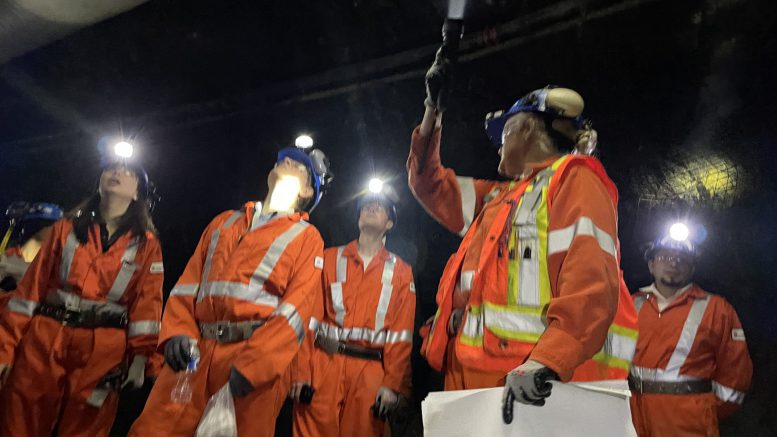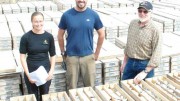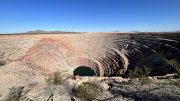Alamos Gold (TSX: AGI; NYSE: AGI) is spending about a billion dollars to become the lowest-cost producer in Canada within three years.
The target is US$576 per oz. all-in sustaining costs at the Island underground mine northeast of Lake Superior in Ontario. As part of a US$756 million phase 3+ expansion, crews are sinking a shaft nearly 1,400 metres deep to slash the time it takes to get to the rock face from nearly an hour and a half to seven minutes. That aims to help double milling capacity to 2,400 tonnes per day.
“It’s the efficiency of being able to get our workforce to the workplace and back on the tools faster,” Luc Guimond, chief operating officer of Alamos, said in an interview at Island, about 80 km north of Wawa. “You centralize your infrastructure, which is your shaft, to your ore body.”
Alamos is investing to take advantage of almost tripling Island’s reserves and resources to 5.3 million oz. since acquiring the site for $US600 million in 2017. It’s part of a larger plan to more than double the company’s annual gold production at Island to 287,000 oz. in 2026 after the expansion. Total output, including the Young-Davidson underground mine in northeast Ontario and the Mulatos mine in Mexico, is forecast at about 600,000 oz. per year after Island’s upgrade.
Free cash flow will rise “significantly” more than the current $150 million a year, chief financial officer Greg Fisher said. Net present value is forecast to jump nearly a third to $2 billion at a 5% discount rate, he said.
Watch a video of the site visit below:
The Toronto-based company is also drilling 26,100 metres this year to expand Young-Davidson near Kirkland Lake, Ont. and 35,000 metres at Mulatos in Sonora state. At Island, the company is pivoting to drilling regional targets on the 550-sq.-km property and shallower depths near the mine after high-grade success in different geology deeper in the mine, Scott Parsons, vice president of exploration, said at a site briefing. Alamos is budgeting US$14 million for 45,000 metres of exploration drilling at Island this year.
“The deposit is completely open at depth and we’re going to get back to underground drilling at depth down plunge once we have the underground infrastructure in place,” Parsons said. “As we shifted away from the deep drilling, we’ve been focusing on these near-mine opportunities and these sub parallel zones.”
This month, Alamos reported hole 580-473-22 in the Island West zone outside of the mine’s reserves and resources area cut 2.2 metres grading 146.3 grams gold per tonne. In the newly defined sub-parallel NS-1 zone of the Island West hanging wall, hole 770-466-03 cut 2.4 metres grading 89.3 grams gold.
Doug Groh, who manages and co-manages more than US$1 billion for Sprott Asset Management in New York including a stake in Alamos, said he was impressed with the site visit after concerns that the stock’s almost one-third gain this year to May 3 wouldn’t be backed up on the ground.
“The exploration activity of the Island mine is really promising as well as the regional district they’re mining in and they are quite ambitious in terms of their objectives,” Groh said as a twin-propellor Dash 8 plane idled nearby. “I really kind of question their objective as far as getting the operating costs to about US$576 an ounce and we’ll see if that works out. But if they have the high grades that they think they have, and it does look that way, it’s likely they’re going to have good operating costs.”
Worker costs
Labour accounts for more than a third of costs at Island and Young-Davidson, following an industry trend to replace oil-based products as mining’s largest expense.
“The biggest challenge that we do certainly have is making sure we maintain a strong labour force to be able to deliver and execute on those plans,” Guimond said. “We consult with our employees to understand their needs and some of the wants they have from the point of view of where they’re operating and working for us in those regions. We’re looking to address those so we can be the employer of choice over the long term.”
Kerry Smith, a mining analyst at Toronto-based Haywood Securities, likewise sees inflation as a bit of a challenge for Alamos but he’s bullish on the company and says Island is on its way to becoming a 10 million oz. deposit while Young-Davidson has greatly improved efficiency with its US$80 million lower mine expansion completed in 2020.
“They’ve got two great mines in Canada and a third good asset in Mexico,” Smith said in an interview after the Dash 8 landed. “The company is in great shape, no debt, lots of cash, self-funding for the expansion, so I think it’s a great story.”
Alamos wants the post-expansion Island, which has a 17-year mine life, to rank as third most profitable mine in Canada behind Agnico Eagle Mines’ (TSX: AEM; NYSE: AEM) Detour Lake and Canadian Malartic. Their respective margins between all-in sustaining costs and a US$1,750 per oz. gold price would be US$506, US$471 and US$337 per oz., Alamos says. It predicts Island will be the largest producer in Canada not held by a major.
M&A?
If Alamos is ticking along so well, why isn’t it a takeover target? Precisely because of that, Smith says.
“It’s always been an expensive stock partly because they’ve got good assets, they’re a low-cost producer, they’ve got a good balance sheet, they’re mostly in Canada, it’s always traded at a good valuation,” he said. “A lot of companies don’t want to pay a premium to a premium and I don’t think Alamos wants to sell. Why would they?”
Island has 4.2 million proven and probable tonnes grading 10.8 grams gold per tonne for 1.5 million oz. contained metal, according to a February update. It also has 1.3 million measured and indicated tonnes grading 7.1 grams gold for 291,000 oz. metal. The grade of its 8.1 million inferred tonnes increased to 13.6 grams gold for 3.5 million ounces.
The mine’s phase 3+ expansion will incorporate technological upgrades such as more electric vehicles, centralized control and optimizations to the hoisting cycle, Island general manager Austin Hemphill said in an interview in front of construction cranes.
“We purposely went by design with proven technology, reliable technologies,” Hemphill said. “We are trying to be as future focused as we can be, but by the same token, we want to be not on the cutting edge, but we want to be first to be second.”
Down in the depths of Young-Davidson, the warm moist air wrinkles the nose with ammonia, a common in mining by-product of water, tailings and paste cement used to replace ore that’s been mined. It gives way to the beef teriyaki aroma of a dust-suppressing application. Shaft operators communicate in a Morse code-style language of buzzes up and down hundreds of metres, drivers tap horns on their spiralling ramp journeys into the earth and Italian ambulance-like sirens guard giant doors aiding ventilation. Watch the video.
Young-Davidson was discovered in 1916 and mined from about 1934 to 1957 before AuRico Gold began production again in 2013. Alamos bought it for $US 750 million in 2015. It has 44.2 million proven and probable tonnes grading 2.4 grams gold per tonne for 3.3 million oz. gold, according to a resource update this year.
“There’s 1.2 km below the previous production boundary to the bottom of our shaft and that’s a pretty significant opportunity in different geology,” exploration vice president Parsons said before extolling other targets on the property such as the area named after the site’s first miner, Matachewan Consolidated Mining.
“This just shows two things. One, there is high grade near surface here at the MCM area and the second is that how little exploration has actually happened to centre it. It’s completely wide open and that will represent the near-term opportunity as we continue to drill.”






Be the first to comment on "Site visit: Alamos Gold targets low-cost output title by 2026 after billion-dollar upgrade "